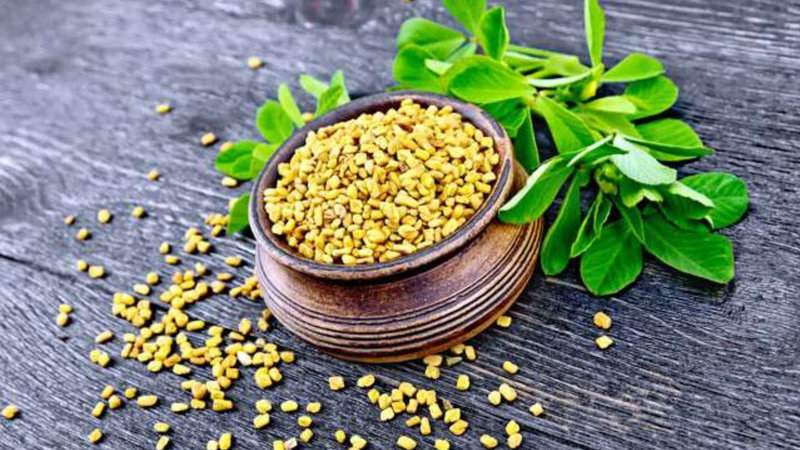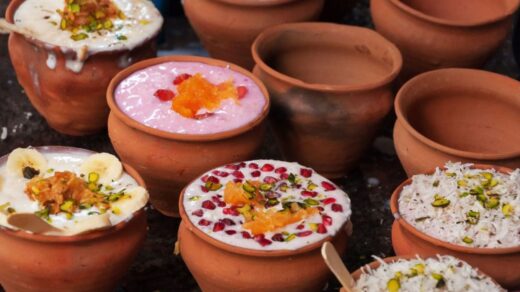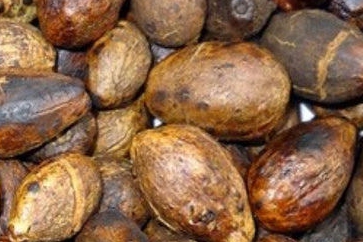Methi Dana In English: The Benefits Of Fenugreek Seeds Water?
Methi dana, or fenugreek seeds, is a versatile spice that is widely used in Indian cuisine. These small, golden-brown seeds have a distinct aroma and a slightly bitter taste. Methi dana adds a unique flavor to dishes and is commonly used in curries, dals, and pickles.
Apart from its culinary uses, methi dana is also valued for its medicinal properties. It has been traditionally used in Ayurvedic medicine for its digestive benefits, including relieving indigestion and promoting bowel regularity.
Additionally, methi dana has gained attention for its potential to regulate blood sugar levels and manage diabetes. It contains soluble fiber that helps slow down the absorption of carbohydrates and sugars.
Which can be beneficial for individuals with diabetes or those looking to control their blood sugar levels. With its distinct flavor and various health benefits, methi dana continues to be a popular ingredient in both traditional and modern kitchens.
In India, it got well flourished and was very commonly cooked like a winter vegetable. It is used in many food recipes such as.
- Methi ka saag: In which the stems and leaves of the plant are used.
- Aloo methi: In which the leaves of the plant with potato are used.
- Kasoori methi: In which dried leaves of the plant are used
Besides this, the seeds are used year-round as a flavoring agent for many dishes.
What Is Methi?
Fen-u-greek is known as Methi by Indians, although there are many regional languages it is commonly as Methi except in the southern part of India. It is an annual herbaceous plant that contains three small obovate to oblong leaflets with light green color and tiny white or yellow flowers.
The plant methi grows upright and high about two to three feet tall. The plant produces yellow-brown flowers that form beans containing fenugreek seeds; these seeds are pungent and aromatic. Methi plan belongs to a pea family (Fabaceae) and it is named Fenugreek derived from the Greek word Foenum-Graecum which means Greek Hay.
How Does Fenugreek Plant Look Like?
Plant:
Fenugreek or Methi is an aromatic plant. Which grows erect that ranges from 1-2 ft about (30-60 cm ) and belongs to the family of Leguminosae (Fabaceae).
Flowers:
Methi flowers are a yellowish-white or sometimes white color that grows from an axil; it has five petals that form up that look like a banner, keel, and wing.
The largest higher flower petal is the banner, it has two lobes that look like petals amalgamated. The smaller two petals form a type; the wings and the last two are generally amalgamated along and form up the keel below the wings.
Leaves:
It has a distinct typical character belonging to the family of Fabaceae. Its leaves are pinnate and trifoliate; they’re deciduous throughout the dry season or during winter.
Seeds:
The seeds are produced in a shell that is about six inches long. The shells are produced from the flower and look like string beans, but Methi’s fruits grow vertically, unlike string beans.
There are about 10 to 20 hard elongated seeds in each pod; they are smooth and dull yellow. The seeds are rhomboid in shape with a deep channel running diagonally from one side to another making each seed into two parts.
The seed sizes are variable; a larger seed can be about 2-.5 cm long and smaller about 15-.35 cm. Seeds when soaked in water become mucilaginous, it contains high amounts of protein and fiber. They are mostly collected during summer to winter (autumn).
Common Names Used In Indian Region
Fenugreek or methi are known by different names around the world with different languages below are some of the names of methi.
- Telugu: Menthulu
- Malayalam : Uluva / Venthiam
- Kannada: Menthe / Menthya
- Hindi: Methi Dana
- Bengali: Methi
- Gujarati: Methi
- Konkani : Methi
- Marathi : Methi Dane / Methi
- Oriya : Methi
- Punjabi : Meth / Methi
- Tulu : Menthae
- Kashmiri : Meeth
- Urudu : Methe
Common Names Around the World
- Arabic: Hulba, Hilbeh
- English : Fenugreek Seeds
- Bulgarian: Sminduh, Sminduh grutski, Tilchets, Chimen
- Burmese: Penantazi
- Chinese (Cantonese): Wuh louh ba
- Chinese (Mandarin): Hu lu ba
- Danish: Bukkehornskløver, Bukkehornsfrø
- Dutch: Fenegriek
- Egyptian: Hemayt (Nunn, 1996)
- Esperanto: Fenugreko
- Farsi: Shanbalile
- Finnish: Sarviapila
- French: Fenugrec, Sénegré, Trigonelle
- German: Bockshornklee, Griechisch Heu
- Greek (old): Telis
- Hebrew: Hilbeh
- Indonesian: Kelabet, Klabat, Kelabat
- Italian: Fieno greco
- Japanese: Koruha, Fenu-guriku
- Korean: Horopa, Penigurik
- Nepali: Methi
- Polish: Kozieradka pospolita; Nasiona kozieradki
- Portuguese: Feno-grego, Alfarva, Alforba, Fenacho
- Romanian: Molotru, Molotru comun, Schinduf
- Russian: Pazhitnik grecheski, Shambala, Pazhitnik cennoj
- Spanish: Alholva, Fenogreco
- Swahili: Uwatu
- Swedish: Bockhornsklöver
- Thai: Luk sat
- Ukrainian: Hunba sinna
Ayurvedic View
Fenugreek is called Methika in Ayurveda; it has been used as medicine for thousands of years for the treatment of arthritis, wounds, abscesses, bronchitis, and for various digestive disorders since ancient times. Ayurveda has two different traditions considering them for treatment such as.
- Father lineage: In this, the medicinal aspects are based upon scriptures, sutras, and the traditions of the (vaidyas) doctors.
- Mother lineage: In this, the remedies are passed on from grandmothers to daughters through generations, by the way, of cooking or home remedies.
These traditions are even seen today in different parts of India and in every village. The methi has its importance in Ayurveda as it is characterized in both category Mother lineage and Father lineage.
Methi has been advisable internally for many conditions such as asthma, high cholesterol, diabetes, fevers, digestive problems, impotence, and cancers, and externally for swellings, burns, and mastitis.
It has also been advised for eaten in winter to improve immunity and to protect the heart, brain, and other vital organs inside the body through its medicinal properties.
Ayurvedic Properties
- Rasa (taste): tikta (bitter)
- Vipaka (post-digestive effect): katu (pungent)
- Guna (quality): Snigdha (unctuous)
- Virya: ushna (heating)
- Karma (actions): rucya, vaatahara (pacifies vata), kaphahara (pacifies kapha), and diipana (digestive)
the benefits of fenugreek seeds water?
Although methi is considered to be one of the oldest medicinal herbs, there is much research in progress currently to uncover new possibilities for its potential.
Below are some of the best uses of methi which you can use without any side effects but one must use it with some precautions. Do you know what are the benefits of soaked fenugreek seeds?
1. It Removes Dandruff
Methi or fenugreek seeds have been effectively used for solving dandruff problems since ancient times. Regular application of these seeds will not only remove dandruff but will also help to gain shiny and long hair. As Fenugreek seeds contain protein and nicotine, they can be extremely useful for hair fall, and dandruff and help to treat a variety of scalp problems like dryness of hair.
It does contain a large amount of lecithin, which hydrates the hair and provides strength to the hair roots making hair shiny and full of luster. Thus regular use of fenugreek can guarantee dandruff frees healthy hair.
How To Use Methi For Dandruff?
Take some methi seeds in a small vessel and soak them overnight to soften them. Next morning, you will methi enlarged with some gel-like substance attached to it, now grind them to make a paste. After the paste is ready apply it to your scalp and massage on the roots of your hair. Let the paste on the scalp for about 20-30 minutes and wash off your hair and say goodbye to dandruff.
Note: You can all add some curd to the paste for the best results.
2. It Controls diabetes
Fenugreek, better familiar to us as Methi may be beneficial to people with diabetes. It is so because the seeds contain fiber and other chemicals that may help to slow down the digestion process.
Slowing the digestion process will improve the body’s ability to absorb carbohydrates and sugar. This way, Fenugreek can help the body to improve the uses of sugar and increases the amount of insulin released.
How to use methi for diabetes?
Take a teaspoon (10 gm) of Methi in a glass of water, and keep it overnight. The next morning drink the water and thoroughly chew the remaining Methi seeds. Repeat this routine for at least 3 months, and you will find the diabetes is under control.
4. It Controls acne scars
Using Fenugreek seeds for treating acne scars is a wonderful idea. It is because of the fenugreek’s diuretic action that helps to eliminate toxins through the digestive system, rather than the skin.
Eliminating toxins through the skin generally can cause infections like acne, thus can help in reducing acne. It additionally fades acne scars beyond unrealistic measures beside this burn marks can also be treated with Methi’s seeds.
How to use methi for acne scars?
Take a tablespoon of methi seeds grind it to powder, and make a paste by adding honey to it. Apply this paste on your pimples at night and wash it off in the morning with slightly warm water. Within a few days, you will notice the differences.
5. It Helps To Reduce Weight loss
Fenugreek has long been used as a spice and as medicine for various ailments. The Methi seed has also been used for weight loss it is one, of the many health benefits of this amazing herb.
Methi seeds are loaded with natural fibers, which lead to the effect of fullness. Drinking methi juice, or chewing methi seeds on an empty stomach can help you to find your calorie cravings departing.
How to use methi for weight loss?
Take 50gm of fenugreek seeds in a glass of water and keep it for the whole night. The next morning drink the water and chew the wet seed on an empty stomach. Repeat this routine for at least 3 months, and you will find reduce in your weight.
6. It Prevents Hair Loss
Today hair loss has become a common problem for all of us. It is due to pollution, stress, improper hair care; harmful chemical-based shampoos, and over usage of hair styling products, etc. are giving rise to hair-loss problems.
Methi seeds contain protein and nicotinic acid; which can be very beneficial in restoring hair roots and reorganizing the damaged hair follicles. Besides this Methi, seeds have many hair benefits like; it decreases dryness on the scalp, taking out dandruff, and softening the hair.
Besides, it’s absolutely safe to use throughout nursing and has been used for hundreds of years to increase breast milk production.

























